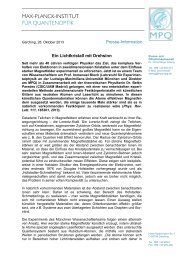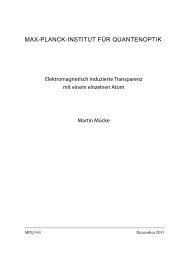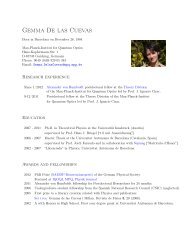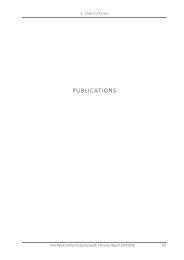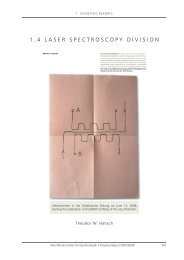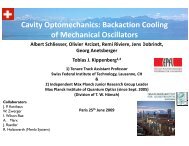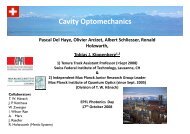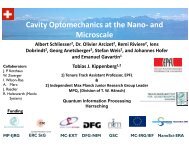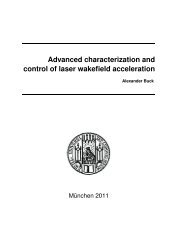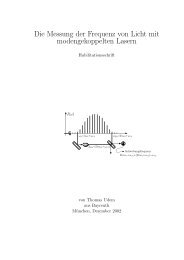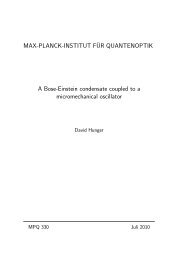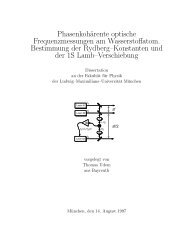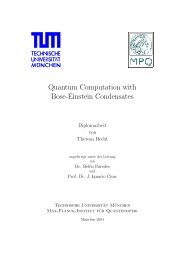Attosecond Control and Measurement: Lightwave Electronics
Attosecond Control and Measurement: Lightwave Electronics
Attosecond Control and Measurement: Lightwave Electronics
You also want an ePaper? Increase the reach of your titles
YUMPU automatically turns print PDFs into web optimized ePapers that Google loves.
JUNIOR RESEARCh GROUPS<br />
1.3.1.5 ATTOSECOND DYNAMICS<br />
Leader: Dr. R. Kienberger<br />
The main goal of the Junior Research Group is to<br />
investigate electronic processes in molecules <strong>and</strong> on<br />
solid surfaces on an attosecond timescale. Efforts have<br />
been undertaken to improve the necessary tools, i.e.<br />
phase-stabilized few-cycle laser pulses, ultrashort pulses<br />
in the ultraviolet (UV) <strong>and</strong> vacuum ultraviolet (VUV),<br />
<strong>and</strong> to develop attosecond beamlines for the envisaged<br />
experiments.<br />
IMPROVEMENT OF ThE lASER SYSTEM TO 1.5 CYClE<br />
lASER PUlSES<br />
The natural limit nature sets to the duration of a light<br />
pulse is one oscillation cycle of the carrier wavelength.<br />
The pulse duration is inversely proportional to the<br />
spectral width of the pulse, i.e. the broader the spectrum<br />
the shorter the pulse. In a chirped pulse laser amplifier,<br />
pulses are temporally stretched for the amplification<br />
<strong>and</strong> have to be compressed subsequently. During the<br />
compression, e.g. in prisms, the pulses normally lose<br />
spectral width due to parasitic effects like self-phase<br />
modulation (SPM). To overcome this problem, we<br />
developed a “hybrid” compressor consisting of prisms<br />
<strong>and</strong> additional chirped mirrors which take over the last<br />
part of the compression without the problem of SPM,<br />
leading to amplified laser pulses lasting only 18 fs.<br />
Sending theses pulses into a gas filled hollow core fiber<br />
<strong>and</strong> final compression resulted in 0.4 mJ laser pulses as<br />
short as 3.8 fs – only 1.5 cycles of the carrier wave [5, see<br />
reprint]. This is a new world record <strong>and</strong> made possible<br />
the generation of intense, ultrashort UV pulses.<br />
GENERATION OF UlTRAShORT UV AND VUV PUlSES<br />
Since the separation of quantum states which are<br />
relevant for electronic dynamics in molecules is on the<br />
order of 5 to 10 eV, ultrashort light pulses at this photon<br />
energy have to be generated. The UV/VUV generation<br />
was performed in a gas jet <strong>and</strong> a special “self diffraction<br />
FROG” (Frequency Resolved Optical Gating) device<br />
has been set up for the full characterization of the UV<br />
pulses.<br />
The spectra we were able to generate in the UV are<br />
extraordinarily broad (Figure 1) <strong>and</strong> could be compressed<br />
to 3.7 fs.<br />
ATTOSECOND TEChNOlOGY ON A SOlID SURFACE<br />
In a collaboration with the University of Bielefeld, a first<br />
attosecond experiment on a solid surface was performed<br />
1 . 3 AT T O S E C O N D A N D H I G H - F I E L D D I V I S I O N<br />
[2, see reprint]. We were able to measure a time delay<br />
between conduction b<strong>and</strong> <strong>and</strong> core level electrons in<br />
single-crystal tungsten as short as 110 as.<br />
Figure 1: Ultrabroad UV spectrum supporting 3 fs<br />
pulses<br />
REFERENCES<br />
[1] Remacle F., Kienberger R., Krausz F., Levine, R.D.;<br />
“On the feasibility of an ultrafast purely electronic<br />
reorganization in lithium hydride”, Chemical Physics<br />
338 (2-3): 342-347 ( 2007).<br />
[2] A. L. Cavalieri, N. Müller, Th. Uphues, V. Yakovlev,<br />
A. Baltuska, B. Horvath, B. Schmidt, L. Blümel, S.<br />
Hendel, P. M. Echenique, M. Drescher, U. Kleineberg,<br />
R. Kienberger, F. Krausz, U. Heinzmann; „<strong>Attosecond</strong><br />
time-resolved photoemission from solids”, Nature 449,<br />
1029 (2007).<br />
[3] Kienberger R, Uiberacker M, Kling MF, Krausz F.;<br />
„<strong>Attosecond</strong> physics comes of age: from tracing to<br />
steering electrons at sub-atomic scales” (invited); J.<br />
Mod. Opt. 54 (13-15), 1985-1998 (2007).<br />
[4] E. Goulielmakis, V. Yakovlev, A. L. Cavalieri, M.<br />
Uiberacker, V. Pervak, A. Apolonsky, R. Kienberger,<br />
U. Kleineberg, F. Krausz; “<strong>Attosecond</strong> <strong>Control</strong> <strong>and</strong><br />
<strong>Measurement</strong>: <strong>Lightwave</strong> <strong>Electronics</strong>”, Science 317,<br />
769 (2007).<br />
[5] A. L. Cavalieri, E. Goulielmakis, B. Horvath, W. Helml,<br />
M. Schultze, M. Fieß, V. Pervak, L. Veisz, V. Yakovlev,<br />
M. Uiberacker, A. Apolonski, F. Krausz, R. Kienberger;<br />
“Intense 1.5-cycle near infrared laser waveforms <strong>and</strong><br />
their use for the generation of ultrabroad-b<strong>and</strong> soft-Xray<br />
harmonic continua”, NJP 9, 242 (2007).<br />
[6] MB. Gaarde, M. Murakami, R. Kienberger; „Spatial<br />
separation of large dynamical blueshift <strong>and</strong> harmonic<br />
generation”, Phys. Rev. A 74 (5), 053401 (2006)<br />
[7] A. Scrinzi, M.Yu. Ivanov, R. Kienberger <strong>and</strong> D. M.<br />
Villeneuve; “<strong>Attosecond</strong> Physics” (invited); J. Phys. B: At.<br />
Mol. Opt. Phys. 39, R1 – R37 (2006).<br />
148 Max-Planck-Institut für Quantenoptik • Progress Report 2007/2008



